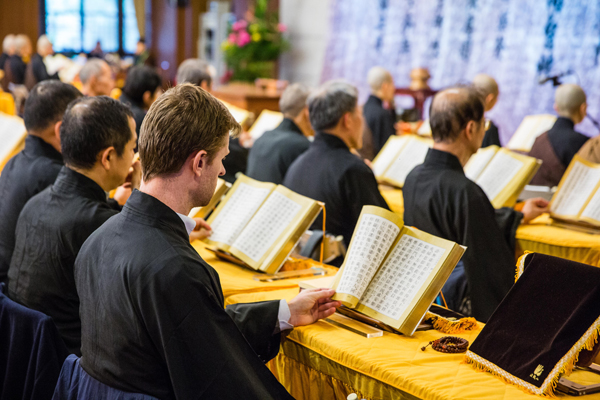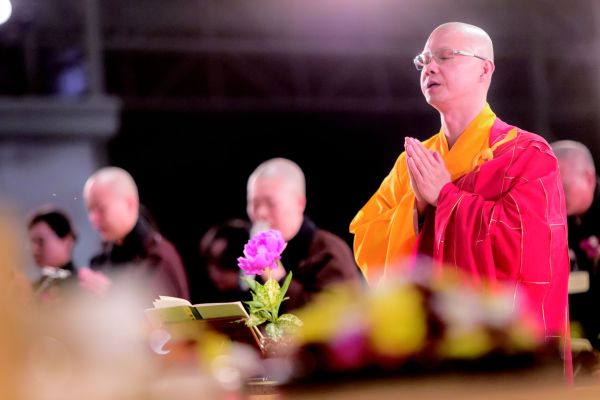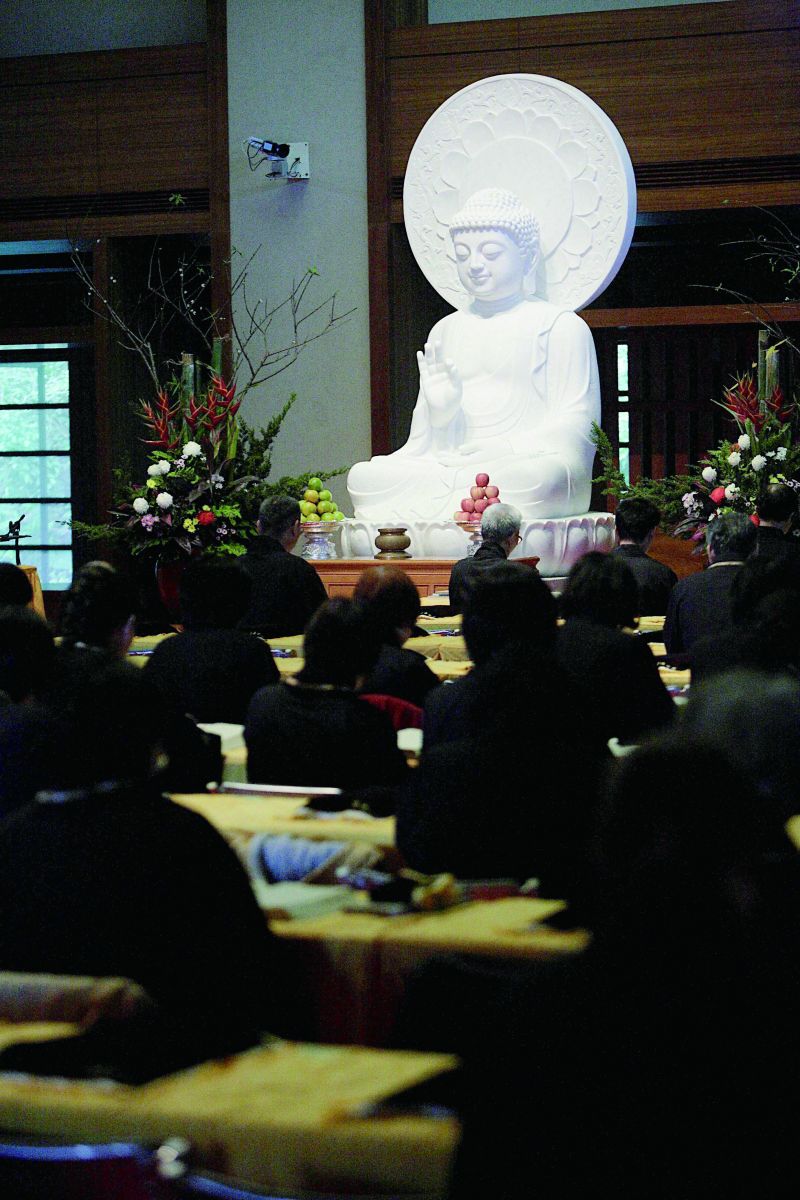Special Topics
What Is a Dharma Assembly?

Speaking of group practices in Buddhism, Dharma Assembly is usually regarded as an introduction to understand Buddhism. However, people who are new to Buddhism and unfamiliar with its meaning and ritual are often left to explore the unfamiliar environment by themselves at a Dharma Assembly. Many people mistake a Dharma Assembly for activities held solely for the purpose of warding off disasters, prolonging life, and delivering the deceased, especially when they follow other participants at the reception to set up memorial nameplates and lamps. What exactly is the original intention of a Dharma Assembly? Were there Dharma Assemblies back in the Buddha's era? What does it mean when we participate in a Dharma Assembly?
Scope of Dharma Assembly
Dharma Assembly, also known as Buddhist or Dharma event, refers to various assemblies for Dharma talks, offerings to the Buddha or Sangha, or food offerings to the deceased. Its fundamental essence is to "gather for the Dharma and to practice accordingly." In general, activities such as morning and evening services in monasteries, regular group practices, and various kinds of repentant activities based on the vows or sutras of the Buddhas and the Bodhisattvas, all fall under the scope of Dharma Assembly.
Dharma Assembly in modern time, combining many practicing methods, such as chanting, offerings, reciting sutras, prostration, reciting Buddhas' names, upholding Mantras, contemplation etc., can be considered unique to Chinese Buddhism. While back in Buddha's era, it was simply a "gathering for Dharma to be listened and expounded."

Buddha, after his enlightenment, traveled on the banks of the Ganges river, shared with people the Dharma in accordance with conditions, and delivered more than 300 Dharma activities. The public listened to the Buddha's lectures, received and recited the precepts together. Kings and rich elders made offerings to the Buddha. All of these events and occasions were regarded as the prototypes of Dharma Assembly.
After the Buddha passed away, the assemblies of expounding and listening to the Dharma were no longer available. Therefore, Venerable Mahakashyapa and five hundred Arahats decided to gather to recollect the teachings of the Buddha. Through chanting and oral recitation among disciples, they developed the fundamental essence of sharing and spreading the Dharma.
Besides reciting the sutras, monks and lay disciples also built stupas, around which they walked, prostrated, offered flowers and chanted merits of the Buddha every morning and evening. The places where Buddha had stayed and stupas built later were not only for the public to visit and worship, but gradually developed into places for regular gatherings. Whenever there was a memorial Dharma Assembly, it would attract even more participants. The activities were no longer limited to Dharma talks and reciting sutras. Out of the reverence and remembrance of the Buddha, participants would offer flowers, lamps, and music. Chanting also became a part of the Dharma Assembly.
Dharma Assembly in modern time, combining many practicing methods, such as chanting, offerings, reciting sutras, prostration, reciting Buddhas' names, upholding Mantras, contemplation etc., can be considered unique to Chinese Buddhism. While back in Buddha's era, it was simply a "gathering for Dharma to be listened and expounded."

Buddha, after his enlightenment, traveled on the banks of the Ganges river, shared with people the Dharma in accordance with conditions, and delivered more than 300 Dharma activities. The public listened to the Buddha's lectures, received and recited the precepts together. Kings and rich elders made offerings to the Buddha. All of these events and occasions were regarded as the prototypes of Dharma Assembly.
After the Buddha passed away, the assemblies of expounding and listening to the Dharma were no longer available. Therefore, Venerable Mahakashyapa and five hundred Arahats decided to gather to recollect the teachings of the Buddha. Through chanting and oral recitation among disciples, they developed the fundamental essence of sharing and spreading the Dharma.
Besides reciting the sutras, monks and lay disciples also built stupas, around which they walked, prostrated, offered flowers and chanted merits of the Buddha every morning and evening. The places where Buddha had stayed and stupas built later were not only for the public to visit and worship, but gradually developed into places for regular gatherings. Whenever there was a memorial Dharma Assembly, it would attract even more participants. The activities were no longer limited to Dharma talks and reciting sutras. Out of the reverence and remembrance of the Buddha, participants would offer flowers, lamps, and music. Chanting also became a part of the Dharma Assembly.
Return to the original intention of the Buddha

Back to the very beginning of Dharma Assembly, it was meant for nothing else but helping us return to the Buddha's original intention through countless expedients. Whether it was Dharma talks by the Buddha, or receiving, upholding, reading, reciting sutras, or Buddhist activities with equal emphasis on both the rituals and doctrines, the purpose has always been to free all sentient beings from sufferings to attain Buddhahood.
The format of Dharma Assembly varies according to different time and space; however, the fundamental essence still remains. For the leading monastics and the attending public, do they realize the original intention of the Buddha? Do they resonate with the dedication of ancient masters who established the repentance rituals?
Participating in a Dharma Assembly is not rubbernecking in temple fairs. It is certainly not the case that once the delivering of the deceased is taken care of by the monastics, all the merits would naturally be fulfilled right away. Participating in a Dharma Assembly is helpful for warding off disasters and delivering the deceased; nevertheless, one is highly recommended to go beyond these worldly comforts.
In daily life, we remind ourselves to open up our mind, integrate the Dharma, and practice accordingly. When participating in a Dharma Assembly, we cultivate awareness through reciting the sutras. Through reading the sutras, we also find out how the Buddhas and the Bodhisattvas empathize with the sufferings of sentient beings and how they deliver them to liberation. Furthermore, we could also extend our earnest compassionate vows and dedicated actions to those around us. Dharma Assembly gives us an opportunity to allow Dharma in sutras and repentant scriptures to transform our lives so that we make ourselves available to serve others. Only by doing so could we truly return to the nature of Dharma Assembly, "Dharma is to be expounded, listened, practiced, and shared."
Resource:
50 Questions about Dharma Assemblies(法會50問), Dharma Drum Publishing Corporation
